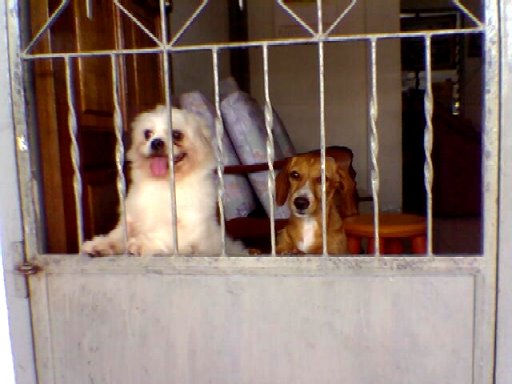How You Can Help Stop Animal Abuse
There's still too much animal abuse in this world. If the story surrounding the conviction of football great Michael Vick doesn't convince you, nothing will. Those of us who care about animals feel compelled to do something to help when we can, but not all of us know what steps we can take. Perhaps a little education and team work could make a world of difference.
Know that there is information and there are resources out there to help you recognize the signs of animal cruelty and give you guidance on what you can do to stop it. A leader in this regard is the ASPCA which, in 2008, partnered with another wonderful organization, Do Something! Do Something's goal is to educate teens through an online community which provides a safe setting where kids can discuss ways in which they can improve the world. One hot topic on their site covers animal welfare.
Do Something provides teen friendly resources and content about animal welfare. The program is quite popular and is a huge success! Since the beginning of the program, the ASPCA has awarded ten $500 grants to teens that have taken action and implemented their very own animal welfare projects. Protecting animals is not just a job for adults; it is a job for young people as well!
If you're wondering what "humane education" is, the ASPCA and Do Something teach us how to care for animals both in our homes and in our communities. The premise fosters respect, empathy and kindness for all beings (on two feet, 4 feet or more), and teaches responsible stewardship for the environment and its inhabitants. The one overriding goal of humane education is to make our planet a more humane and kind place to live.
Ultimately, making a difference requires action by people just like you. Does the idea of making the world a better place for animals appeal to you or your kids? Are you up to the challenge? Are you wondering what you can do to help? Every one of us can make a difference. If you're wondering where to begin, consider some of the following ideas.
Know who to call! For example, the ASPCA located in New York City has a team of animal cruelty officers. These officers are responsible for researching and investigating each and every animal abuse case that is reported. Find out what agency or group is responsible in your community and keep their phone numbers handy! Whether it be the local police department or a city run animal control agency, know who to call for help!
Keep an eye out for dogs in your neighborhood that are repeatedly left alone and chained outside. It is especially important to monitor their food and water supply. You might just be surprised at how many animals are chained to a tree and left with NO food or water.
Make sure your children grow up to be responsible citizens by educating them on animal welfare issues. Teach them to be compassionate and respectful of animals and ensure they know that dogs and cats experience feelings and emotions such as pain, sadness and joy just as we do. By taking this step, you are doing your part to take care of our animals well in to the future.
Should you witness animal abuse, avoid getting involved directly. Call the authorities and let them deal with the situation. It is difficult to stand back while abuse is going on, but you expose yourself and your family to the risk of retaliation should you try to take matters into your own hands. Responsible agencies will act even if the report is made anonymously.
Fight for stronger animal cruelty laws! Jump on board and join the ASPCA Advocacy Brigade! If society implements stronger cruelty laws and harsher penalties maybe, just maybe, people will take the humane treatment of animals more seriously. Animal abuse is no laughing matter; make sure your voice is heard! The best way to do this is by signing anti-cruelty petitions and writing letters to your local legislators asking for tougher laws!
Making a real difference costs you nothing but a little bit of your time and there's much you can do. It starts with awareness and education. Join together and make a difference in the lives of the animals who ask so little of us but give back so much in terms of love, loyalty and friendship. You CAN make a difference.
Know that there is information and there are resources out there to help you recognize the signs of animal cruelty and give you guidance on what you can do to stop it. A leader in this regard is the ASPCA which, in 2008, partnered with another wonderful organization, Do Something! Do Something's goal is to educate teens through an online community which provides a safe setting where kids can discuss ways in which they can improve the world. One hot topic on their site covers animal welfare.
Do Something provides teen friendly resources and content about animal welfare. The program is quite popular and is a huge success! Since the beginning of the program, the ASPCA has awarded ten $500 grants to teens that have taken action and implemented their very own animal welfare projects. Protecting animals is not just a job for adults; it is a job for young people as well!
If you're wondering what "humane education" is, the ASPCA and Do Something teach us how to care for animals both in our homes and in our communities. The premise fosters respect, empathy and kindness for all beings (on two feet, 4 feet or more), and teaches responsible stewardship for the environment and its inhabitants. The one overriding goal of humane education is to make our planet a more humane and kind place to live.
Ultimately, making a difference requires action by people just like you. Does the idea of making the world a better place for animals appeal to you or your kids? Are you up to the challenge? Are you wondering what you can do to help? Every one of us can make a difference. If you're wondering where to begin, consider some of the following ideas.
Know who to call! For example, the ASPCA located in New York City has a team of animal cruelty officers. These officers are responsible for researching and investigating each and every animal abuse case that is reported. Find out what agency or group is responsible in your community and keep their phone numbers handy! Whether it be the local police department or a city run animal control agency, know who to call for help!
Keep an eye out for dogs in your neighborhood that are repeatedly left alone and chained outside. It is especially important to monitor their food and water supply. You might just be surprised at how many animals are chained to a tree and left with NO food or water.
Make sure your children grow up to be responsible citizens by educating them on animal welfare issues. Teach them to be compassionate and respectful of animals and ensure they know that dogs and cats experience feelings and emotions such as pain, sadness and joy just as we do. By taking this step, you are doing your part to take care of our animals well in to the future.
Should you witness animal abuse, avoid getting involved directly. Call the authorities and let them deal with the situation. It is difficult to stand back while abuse is going on, but you expose yourself and your family to the risk of retaliation should you try to take matters into your own hands. Responsible agencies will act even if the report is made anonymously.
Fight for stronger animal cruelty laws! Jump on board and join the ASPCA Advocacy Brigade! If society implements stronger cruelty laws and harsher penalties maybe, just maybe, people will take the humane treatment of animals more seriously. Animal abuse is no laughing matter; make sure your voice is heard! The best way to do this is by signing anti-cruelty petitions and writing letters to your local legislators asking for tougher laws!
Making a real difference costs you nothing but a little bit of your time and there's much you can do. It starts with awareness and education. Join together and make a difference in the lives of the animals who ask so little of us but give back so much in terms of love, loyalty and friendship. You CAN make a difference.
About the Author:
Before you purchase electronic training collars, take the time to learn the safe and responsible way to use training collars for dogs.














.jpg)






.jpg)

0 comments:
Post a Comment